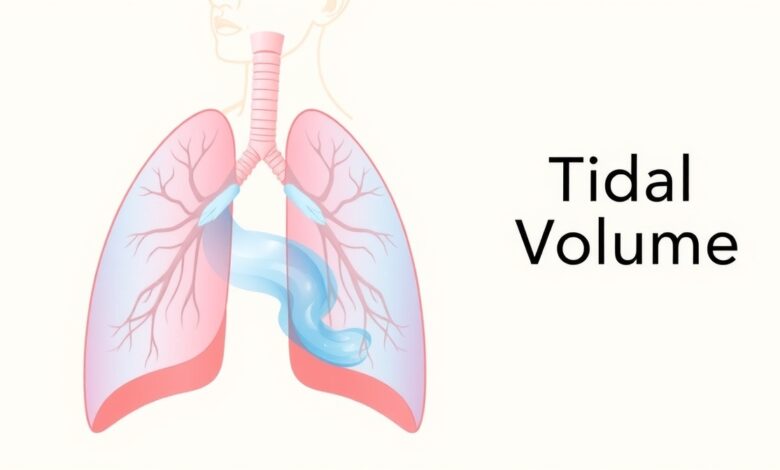Tidal Volume The Simple Guide to Understand How Much Air You Breathe

Tidal Volume is the amount of air your lungs take in and push out when you breathe normally. Every time you breathe in, your lungs fill up with air, and when you breathe out, that air goes out again — this movement of air is called tidal volume. It shows how healthy and strong your lungs are. Knowing about tidal volume is very important because it helps doctors and people like you understand how your body breathes and how much air is needed to keep you alive and active. In simple words, tidal volume tells us how well our lungs work every second we breathe. It helps measure how much air goes in and out during normal, calm breathing.
When we take deep breaths, the tidal volume changes. It gets bigger when you take a deep breath and smaller when you breathe softly. Doctors and health experts often measure tidal volume in hospitals using machines to check if a person’s lungs are working fine.
Easy Meaning of Tidal Volume for Kids and Beginners
Tidal volume means how much air goes in and out of your lungs when you breathe normally. Imagine blowing a balloon softly — that air you blow in is like tidal volume for your lungs. It shows how much air your lungs can handle in one breath. For kids, it is an easy way to learn about how breathing works inside the body. When you run, laugh, or rest, your tidal volume changes a little. It becomes bigger when you breathe deeply and smaller when you rest quietly. Learning about tidal volume helps you understand how your lungs help you live and play every single day.
Simple Formula to Calculate Tidal Volume Step by Step
You can find tidal volume using a simple formula: Tidal Volume = Minute Ventilation ÷ Breathing Rate. Minute ventilation means the total amount of air you breathe in one minute, and the breathing rate means how many times you breathe in one minute. So, if a person breathes 12 times per minute and moves 6 liters of air, the tidal volume is 0.5 liters per breath. This means each time they breathe in or out, about half a liter of air moves. It’s easy to remember and helps doctors measure breathing health. This simple formula helps everyone understand how much air lungs can take in one normal breath.
How to Measure Tidal Volume Using Easy Tools
Tidal volume can be measured with simple medical tools like a spirometer. A spirometer is a machine that checks how much air goes in and out of your lungs when you breathe. It has a mouthpiece where you breathe slowly, and it shows your breathing number on a screen. Doctors and nurses use this tool in hospitals to check how strong your lungs are. It is very easy and safe to use. Even people learning about breathing can try it to understand tidal volume better. Measuring tidal volume helps find out if your lungs need care or are working well enough to keep you healthy.
Difference Between Tidal Volume and Lung Capacity Explained
Tidal volume and lung capacity are both about breathing, but they are not the same. Tidal volume is just the small amount of air you breathe in and out normally. Lung capacity is the total amount of air your lungs can hold when they are full. Think of tidal volume as a cup of water and lung capacity as a big jug. The jug can hold more water, but you only drink one cup at a time — just like your lungs use only part of their capacity with each breath. Knowing this difference helps you understand how your lungs work smarter every moment.
Why Tidal Volume Changes During Exercise and Rest
Tidal volume changes when your body works harder or rests quietly. When you exercise, your body needs more oxygen to make energy, so you breathe deeper. This makes your tidal volume bigger because your lungs take in more air. When you rest, your body doesn’t need that much oxygen, so your breaths become smaller and slower. That means your tidal volume becomes smaller again. These changes are normal and healthy because your lungs adjust to what your body needs. This helps your heart, muscles, and brain work better while keeping you full of energy and freshness all day long.
Real-Life Examples to Understand Tidal Volume Clearly
Imagine blowing up a balloon softly — the air you blow in is like your tidal volume. When you breathe in while reading or sleeping, that’s your normal tidal volume. But when you run, play football, or dance, your lungs work faster, and the tidal volume grows because your body needs more air. Doctors use this idea in hospitals to check patients’ breathing with machines called ventilators. Even animals have tidal volume! It helps every living thing get oxygen and stay alive. So next time you take a deep breath, remember — that air is your tidal volume in action!
Factors That Can Affect Your Tidal Volume Every Day
Many things can change your tidal volume every day. Your age, size, health, and how active you are can all make a difference. When you are sick or tired, your tidal volume might get smaller because your lungs cannot take in as much air. When you are healthy or doing exercise, it becomes larger because your lungs are strong. Stress, posture, and even the weather can change how you breathe too. Taking care of your body with good food, fresh air, and exercise helps your lungs work better. Keeping a healthy tidal volume means having strong lungs for life.
Importance of Tidal Volume in Breathing and Health Care
Tidal volume is very important for good breathing and healthy living. It helps doctors check if your lungs are working normally and if your body is getting enough oxygen. In hospitals, tidal volume helps set machines for patients who can’t breathe on their own. It also helps athletes improve their breathing power. For everyone, knowing about tidal volume means understanding how our body keeps us alive. Each breath we take brings new air, helps our cells, and removes waste gases. Without good tidal volume, our body can’t stay strong and healthy. That’s why breathing right is always important.
Conclusion
Breathing is something we do all the time, but we rarely think about it. Tidal volume is the simple science behind every breath you take. It shows how much air your lungs can handle when you breathe in and out. When you know your tidal volume, you learn how your lungs work to keep your body full of oxygen. This helps you stay healthy, active, and happy every day.
Tidal volume changes when you run, laugh, or rest. Your body is smart — it knows how much air you need each time. If you exercise or play sports, your lungs grow stronger, and your tidal volume improves. Breathing deeply every day can make your lungs more powerful and keep your mind fresh.
FAQs
Q1: What is tidal volume in simple words?
Tidal volume is the amount of air you breathe in and out during normal breathing.
Q2: Why is tidal volume important for health?
It helps doctors know if your lungs are working well and if your body is getting enough air.
Q3: How is tidal volume measured?
It is measured using a spirometer that shows how much air moves in and out of your lungs.
Q4: Does tidal volume change when we exercise?
Yes, it increases during exercise because your body needs more oxygen.




